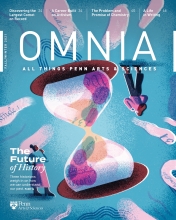Forgetting Doesn’t Heal
Stephanie Gibson, a doctoral candidate in the history of art, explores monuments of trauma in Africa, the Caribbean, and the Black Atlantic.

Prisoners in Philadelphia’s historic Eastern State Penitentiary spent 23 hours a day alone in their thick-walled cement cells, released for a single hour during which they still had no human contact. Established in 1829, the penitentiary pioneered solitary confinement, a practice that led inmates to experience paranoia, delusions, anxiety attacks, psychotic episodes, and suicidal tendencies—repercussions that went unaddressed for decades as more than 300 prisons worldwide copied the institution’s system of isolation.
Now a museum, Eastern State maintains an exhibit condemning mass incarceration and solitary confinement. The site’s conversion is among the case studies Stephanie Gibson, G’20, doctoral candidate in the history of art, will feature in her dissertation about monuments of trauma in Africa, the Caribbean, and the Black Atlantic.
“I’m interested in how museums and commissioners and designers of monuments are interpreting sites with painful histories to help people move past the trauma that occurred there,” says Gibson, who has a bachelor’s degree in art history, criticism, and conservation from Emory University and a master’s degree in art history from Penn, and expects to complete her Ph.D. in spring 2023. “Working through trauma requires a listener. When we give space in our architectural landscape for stories of the oppressed to be told, we as a society are lending our ears to those stories, allowing for catharsis and healing.”
Eastern State’s explicit criticism of its own history exemplifies this phenomenon, Gibson explains. Through multimedia installations and an interactive tour that is sometimes guided by staff who were formerly incarcerated, the museum promotes criminal justice reform and shows visitors they are closer to the prison industrial complex than they might believe.
“The tour changes people. You get to understand what it was like to be a prisoner confined within that cell, even if it’s only for 30 seconds,” she says. “You are asked whether you have ever committed any crime, like underage drinking or something else that most people don’t even think could have led them to incarceration. It makes you question your own truth and challenges the way you view the world.”
Raised in Bermuda, Gibson is examining a similar transition in the island’s Casemates Barracks and Prison, another shuttered penal institution being converted into a museum. In 1977, two Black prisoners were hanged there, sparking protests, riots, and increased racial tension.
“It’s fascinating to me when actual sites of incarceration and trauma flip the way we punish people on its head. I’m wondering what Casemates can learn from Eastern State as they move forward in developing their own museum,” she says.
Last year, Gibson received a graduate fellowship through Monument Lab, a Philadelphia-based studio that examines the way history is portrayed through art in public spaces. She used this opportunity to scrutinize the representation—and misrepresentation—of Black trauma through monuments and memorials, beginning with the statue of Sally Bassett, an 18th-century Bermudian slave burned at the stake for trying to poison her granddaughter’s enslavers.
Gibson’s family lives close to where Bassett was executed; she drives past the spot regularly whenever she’s home in Bermuda. But an unrelated monument stands at the site, with Bassett’s statue obscured in a more remote location because, as Gibson says, some locals protested being “forced” to see it.
“They did not want to reckon with the atrocities that their ancestors committed. Such thinking perfectly demonstrates why the monument should be in public view,” she wrote for Monument Lab. “An avoidance of the past signals an unwillingness to properly work through history.”
Gibson has lobbied for Bassett’s statue to replace the one that currently stands at her execution site, a movement that is steadily gaining momentum. Particularly in the U.S., she notes, many activists have been fighting for the removal of offensive monuments, like those depicting Confederate leaders and other racist symbols. Calling her work “the other side of the coin,” Gibson focuses on the erection of memorials to figures from marginalized communities.
“Once we remove people who should never have been heralded, how should we fill that space? I am more interested in the putting up than the taking down, in making sure we fill our monumental landscape with people and things that deserve to be remembered,” says Gibson, who aspires to be an art history professor. “Monuments are part of the narrative that our society tells the world, and the stories we tell should be true.”
Gibson will present “Trauma Behind the Walls: A Case Study of Eastern State Penitentiary” during a Penn History of Art Virtual Colloquium on Friday, October 1, at 3:30 p.m. For more information, visit arth.sas.upenn.edu/events.



